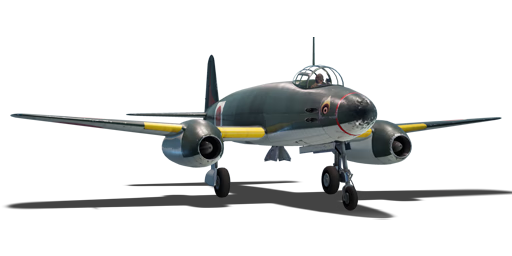

In 1943, the Yokosuka Naval Arsenal started the development of a high-speed, high-altitude reconnaissance aircraft capable of outrunning any pursuing fighters. The project was later given the designation R2Y Keiun (Cirrus Cloud). The first prototype, designated R2Y1, was an unarmed piston aircraft powered by the Aichi Ha-70 coupled engines, giving an impressive top speed of up to 718 km/h. After the R2Y1 made its first flight on 8 May 1945, a proposal was made to repurpose the Keiun into a jet-powered light bomber. Designated the R2Y2 Keiun Kai, the R2Y2 was to be powered by two Mitsubishi Ne-330 turbojet engines and have a provision of up to 800 kg of bombs. However, after the sole R2Y1 prototype was destroyed in a bombing raid a few days later, the R2Y project as a whole was cancelled.
The "R2Y2 Kai V1" was introduced in Update 1.43. The "V1" represents the original configuration of the R2Y2, with engines mounted below the wings. Compared to most early jets, the Keiun is quite large but also deceptively agile. With enough energy and marksmanship, the Keiun is capable of dispatching any enemy fighters with its slow-firing but powerful cannons. However, care must be taken not to overextend and waste precious energy, as the Keiun takes considerable time to gain momentum in-flight. For ground attack purposes, the Keiun can utilise a large 800 kg bomb that is capable of destroying most ground vehicles within its proximity, as well as penetrating lighter vehicles with its cannons.
flaps
flaps
flaps
brake
| Belt | Belt filling | Armor penetration (mm) at a distance: | |||||
|---|---|---|---|---|---|---|---|
| 10 m | 100 m | 500 m | 1000 m | 1500 m | 2000 m | ||
| HEF/HEF-I/HEF-T/APHE | 38 | 36 | 28 | 21 | 16 | 12 | |
| HEF-T/HEF-I/APHE/HEF/HEF | 38 | 36 | 28 | 21 | 16 | 12 | |
| HEF-T/APHE/APHE/APHE | 38 | 36 | 28 | 21 | 16 | 12 | |
| HEF-T | 5 | 5 | 4 | 3 | 3 | 3 | |
| HEF | 5 | 5 | 4 | 3 | 3 | 3 | |












Flight performance |
|---|
Survivability |
|---|
Weaponry |
|---|